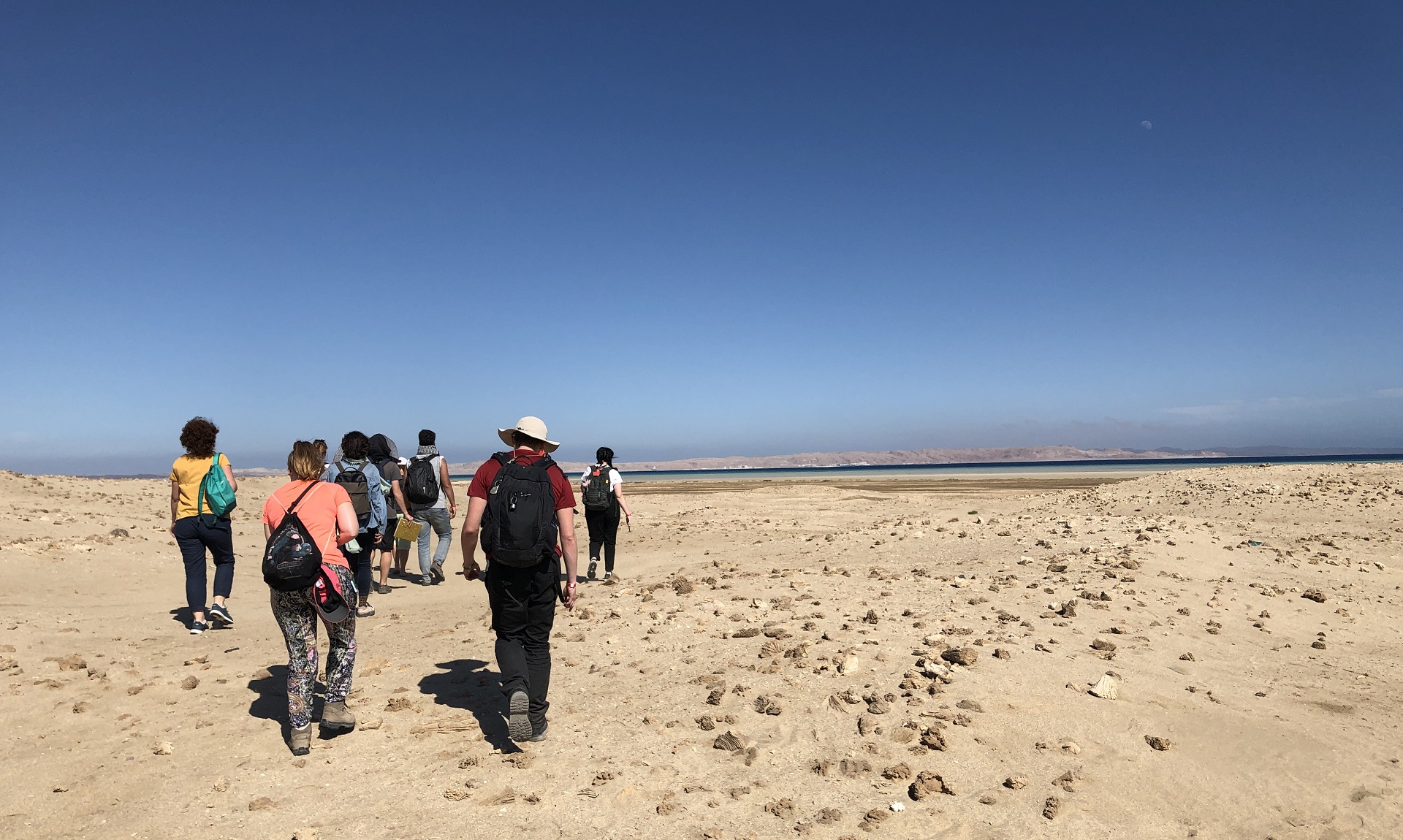Week 5: 2–8 February, 2020
This week marked the beginning of our 3-night stay in Marsa Alam. Our drive from Edfu to the Red Sea coast took us through the Eastern Desert, where we had two stops planned. The first stop was the rock temple of Kanais, where Isobel gave an interesting site presentation about this temple which was discovered by 19th century explorers but has not seen extensive study beyond its texts (Fig. 1). The temple was built by Seti I and dedicated to Amon-Ra and his Ennead, in which Seti I included himself. The temple acted as an administrative centre for gold-mining activities in the region, as well as having a well nearby to serve expeditions travelling across the desert from Edfu to Berenike. Unfortunately the temple was locked by a gate, but peeking through the bars we were able to get a sneak peek of the interior nevertheless. Afterwards, we spent some time roaming the site where we saw some interesting remains. We explored the ruins opposite of the temple, which was probably a Roman fort and water station, and saw some rock art, ancient stelae and some live scarab beetles.

While driving away from Kanais, we drove through the Wadi Barramiya, which is known for several areas of rock art. However, our security accompaniment did not want us to get off the bus to explore. While driving along, Jake spotted some ancient rock art directly next to the highway, and luckily, we were allowed to get off the bus this time and see it up close (Fig. 2). There were boats and a man riding a camel carved in the rock: very interesting and cool to see!

The main trip of this week was to Berenike, where we visited Olaf Kaper, who currently joins the Polish-American mission excavating there (Fig. 3). Iwona Zych from the Polish Center in Cairo took us around the site and told us about its history (Fig. 4). Berenike was a Greco-Roman Period harbor and settlement: the first record of Berenike was of the Hellenistic fort built by Ptolemy II and his father, named ‘Berenike’ after Ptolemy II’s mother. Berenike’s port was the major port in the Augustan Period and was the output of everything that came from Egypt, Mediterranean and Levant and traded these goods with Saudi Arabia and India, reaching as far as the Far East. One important commodity to pass through the port was elephants from Africa: about two dozen of these expeditions took place to bring elephants for use in the army, staying in Berenike for 2-3 weeks until the elephants were steady enough to continue their journey. A broken molar tooth and pieces of an elephant skull prove the existence of these animals at the site. The population of the settlement was made up from sailors and merchants, military and administrators, and local indigenous population such as fishermen. In the sixth century, the site seems to have been abandoned in a peaceful way, the population perhaps pushed into the hills by a plague travelling up the coast at the time.


From 1994-2001, the Dutch-American Expedition worked here, changing to the current Polish-American Expedition in 2001, still with Dutch input, including Olaf Kaper. Iwona Zych took us to the trenches of the Roman cemetery and the well, the harbor area, the two temples on the harbor island, the most south-eastern church of the Roman empire, and the Tetrastylon. Even though few remains are visible as they have been completely backfilled in order to preserve them, Iwona Zych’s stories filled in the blanks and made the site come to life! She also taught us a valuable lesson as future archaeologists: Keep your ideas open and think about it yourself before following the conclusions of others.
When Iwona was done guiding us, she dropped us off at the temple of Isis where we were enthusiastically greeted by Olaf Kaper, who is working in this area (Fig. 5). The temple of Isis is the only temple in the entire Red Sea coast that is of Egyptian architecture and decoration style. It must already have been there in the Ptolemaic Period, but the most that is now visible is from the Roman Period. The temple consists of a forecourt of 20 meters long that is lined with Greek stelae. Rodney Ast told us a little more about these Greek stelae in the best preserved part of the forecourt which is now protected by a modern structure and access requires crawling through a very small opening. The forecourt had two side doors, one of which was being excavated by Sylvia Prell, whose team had dug a shaft of about 3 meters deep before hitting the pavement. The temple itself was built according to a typical temple plan: a sanctuary in the back, an offering hall and a staircase to the roof on the left. As the temple is made from gypsum, which crumbles when subjected to moisture, the temple will be backfilled when the excavations and documentation are finished. This makes our visit to the site and its temple even more special, as we are now some of the only people to ever see the monument in real life. All in all, our visit to Berenike was an interesting and unique experience.

After a day of relaxing at Marsa Alam, it was then time to end our trip to the south and fly back to Cairo. The plane hit some turbulence on the way, but nothing to worry about and we made it to Cairo safely. On our first entire day back in Cairo, there was another captivating lecture at the NVIC. This time, Ilona Regulski of the British Museum talked about tomb M.12.3 at Asyut, where the Middle Kingdom tomb’s inscriptions could evidence an administrative reform limiting the power of local governors, or simply a change in the usage of the titles of these high officials.
Charlotte van Rijsbergen & Isobel Dewar-Fowler

